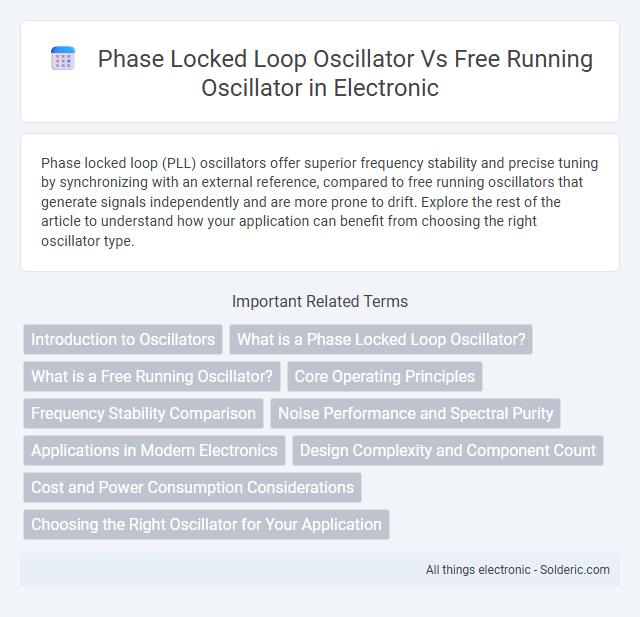Phase locked loop (PLL) oscillators offer superior frequency stability and precise tuning by synchronizing with an external reference, compared to free running oscillators that generate signals independently and are more prone to drift. Explore the rest of the article to understand how your application can benefit from choosing the right oscillator type.
Comparison Table
| Feature | Phase Locked Loop (PLL) Oscillator | Free Running Oscillator |
|---|---|---|
| Frequency Stability | High stability due to feedback control | Moderate to low stability; dependent on component variations |
| Frequency Accuracy | Precise frequency locking to reference signal | Less accurate; frequency drifts with temperature and aging |
| Frequency Control | Adjustable by reference input frequency | Fixed by component values (resistors, capacitors) |
| Phase Noise | Low phase noise due to phase correction | Higher phase noise without corrective feedback |
| Complexity | More complex circuit with phase detector and loop filter | Simple oscillator circuit |
| Applications | Communication systems, frequency synthesis, synchronization | Basic timing, clocks, simple RF generation |
| Power Consumption | Typically higher due to additional components | Lower power consumption |
Introduction to Oscillators
Oscillators generate periodic signals essential for communication and signal processing systems. A phase-locked loop (PLL) oscillator maintains frequency stability by synchronizing its output to a reference signal, reducing phase noise and jitter. Free running oscillators operate independently without synchronization, often exhibiting more frequency drift due to temperature and component variations.
What is a Phase Locked Loop Oscillator?
A Phase Locked Loop (PLL) oscillator is a control system that generates stable, tunable frequencies by locking the output phase of a voltage-controlled oscillator (VCO) to the phase of a reference signal. It continuously adjusts the oscillator's frequency to maintain a constant phase difference, minimizing frequency drift and noise. Unlike free running oscillators that operate independently, PLL oscillators provide precise frequency synthesis and enhanced signal stability for communication systems and signal processing applications.
What is a Free Running Oscillator?
A Free Running Oscillator is an electronic circuit that generates a continuous periodic waveform without requiring an external reference signal, relying solely on its internal components to sustain oscillations. It operates at a fixed frequency determined by the circuit elements such as inductors, capacitors, and resistors, making it simpler but less precise compared to a Phase Locked Loop (PLL) oscillator. Unlike PLL oscillators, Free Running Oscillators lack frequency stabilization and adaptive synchronization, leading to potential frequency drift with temperature variations and component aging.
Core Operating Principles
Phase locked loop oscillators synchronize their output frequency with an input reference signal using a feedback control system that adjusts the oscillator to maintain a constant phase difference. Free running oscillators generate a stable frequency based solely on their internal resonant circuit without any external input or feedback for frequency correction. Understanding these core operating principles helps you select the appropriate oscillator type for applications requiring either precise frequency control or autonomous signal generation.
Frequency Stability Comparison
Phase locked loop (PLL) oscillators exhibit superior frequency stability compared to free running oscillators due to their ability to lock onto a reference signal, minimizing frequency drift caused by temperature and component variations. Free running oscillators rely solely on their internal components, which makes their output frequency more susceptible to environmental changes and aging effects. Your circuit design benefits from using a PLL oscillator when precise and stable frequency generation is critical.
Noise Performance and Spectral Purity
Phase locked loop (PLL) oscillators exhibit superior noise performance by actively synchronizing their output frequency with a stable reference, significantly reducing phase noise and enhancing spectral purity compared to free running oscillators. Free running oscillators, relying solely on their intrinsic resonator characteristics, tend to exhibit higher phase noise and broader spectral linewidths due to drift and environmental variations. The closed-loop feedback mechanism in PLL oscillators effectively suppresses frequency instability and spurious signals, resulting in cleaner, more stable output spectra essential for high-precision communication systems.
Applications in Modern Electronics
Phase locked loop (PLL) oscillators find extensive use in modern electronics for frequency synthesis, clock generation, and demodulation tasks in communication systems due to their ability to maintain stable output frequencies locked to a reference signal. Free running oscillators are widely applied in low-power and cost-sensitive devices like microcontrollers and real-time clocks, where continuous oscillation without external reference synchronization is sufficient. PLLs offer superior performance in frequency stability and phase noise reduction, making them essential in RF transceivers, while free running oscillators provide simplicity and low jitter in embedded applications.
Design Complexity and Component Count
Phase-locked loop (PLL) oscillators exhibit higher design complexity and component count compared to free-running oscillators due to the integration of a phase detector, voltage-controlled oscillator, and loop filter for frequency stabilization. Free-running oscillators rely on fewer components, typically consisting of a resonant circuit and active device, resulting in simpler design and reduced component requirement. The increased components in PLL oscillators enable accurate frequency control and stability but demand more intricate circuit design and tuning.
Cost and Power Consumption Considerations
Phase locked loop (PLL) oscillators generally incur higher costs and power consumption compared to free running oscillators due to their complex circuitry and active feedback components required for frequency stabilization. Free running oscillators are simpler in design, resulting in lower manufacturing costs and minimal power usage, making them suitable for applications where power efficiency is critical. However, PLL oscillators offer superior frequency accuracy and stability, often justifying the increased resource demands in precision electronics.
Choosing the Right Oscillator for Your Application
Phase locked loop (PLL) oscillators offer superior frequency stability and noise reduction compared to free running oscillators, making them ideal for applications requiring precise signal synchronization and minimal phase noise. Free running oscillators, however, provide simpler designs and lower power consumption, suitable for less demanding tasks where cost and power efficiency are critical. Your choice hinges on application needs for accuracy, complexity, and power constraints.
Phase locked loop oscillator vs Free running oscillator Infographic

 solderic.com
solderic.com